Laurie and I went to the local bakery today to buy some treats for a celebratory gathering tonight and found these meringue shoes:
We had to buy a pair. I suspect they’ll get eaten before Henry sees them.
Laurie and I went to the local bakery today to buy some treats for a celebratory gathering tonight and found these meringue shoes:
We had to buy a pair. I suspect they’ll get eaten before Henry sees them.
Henry George Zumsteg was born to Craig and Annie this morning at 3:45, New York time. Henry weighed in at 8 lbs, 2 oz, 20 inches. No word yet as to whether he got his sister’s red hair. Mom, Dad and baby are all doing well.
We’re grandparents again, and happy as can be. Champagne will be drunk tonight (they have some here in France)!
Update: A picture!
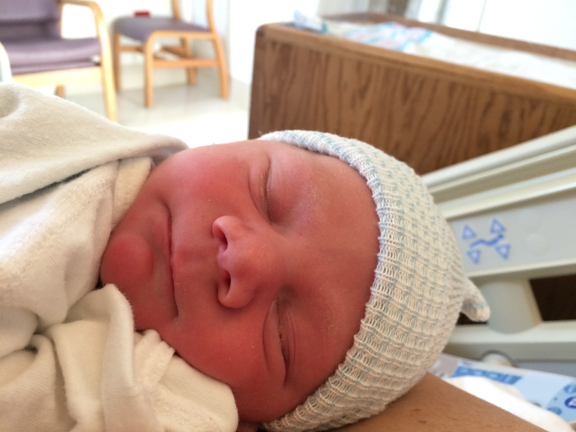 We happen to think he’s the handsomest grandson ever born. We might be biased.
We happen to think he’s the handsomest grandson ever born. We might be biased.
Last Friday we saddled up the trusty old Renault and headed to Brittany to celebrate a bunch of birthdays. Our friends Jamie and Hervé Rufin, who have vacationed on the Presq’ile Quiberon for a number of years, last year bought a beautiful house there and invited three couples to join them over a long weekend; three of the four wives were celebrating birthdays that weekend, Laurie’s is not too far away, and one husband’s was the day before we arrived – a plethora of reasons to celebrate!
First, where were we? The Quiberon Peninsula is on the southwestern edge of Brittany:
Here are some pictures of Saint-Pierre-Quiberon:
On the other side of the peninsula is the Côte Sauvage – the Wild Coast. It reminds us a lot of the Oregon coast.
We walked a lot on the Côte Sauvage, especially at low tide; very beautiful. I even went into the water, and though I tried to stay in, I couldn’t make it warm enough, so I didn’t last long.
And there were birthdays to celebrate. We arrived on Friday, July 31; Saturday was Valérie’s birthday, Sunday was Mary’s and Monday was Jamie’s (and the day before had been Yves – Valérie’s husband.) And they decided to include Laurie, whose birthday is only a month away. So there was some serious celebrating to do.
We went out for a wonderful – at the time – meal Saturday night, then Sunday night we had dinner at chez Rufin, where the kitchen was in full swing, and Gilles took over duties as Master Barbecuer and Carver.
Unfortunately, early the next morning three of us encountered a serious side affect of something, as Jamie, Laurie and I all had what can only have been food poisoning. The one thing we ate in common was oysters for a first course Saturday night, and there are indeed, food poisoning bacteria that take 24 hours to develop. The three of us pretty much spent the day in bed Monday. That was Jamie’s birthday; what a way to spend it. Fortunately, by Tuesday she was still tired, but had recovered enough to have a small celebration.
Monday, the group – less Valérie and Yves, who had family commitments that took them away – went to one of our favorite places in the world: Carnac. This is the home of the largest collection of menhirs (standing stones) in the world. This time, we took an excellent tour (in English!) inside the fences that surround the alignments. Because tourists were causing damage to the alignments, they were closed off twenty-five years ago and the only way to get inside is to take a tour, so we did. We learned lots and though you can see the alignments well from outside the fences, it was great to get inside and see them from a close-up and personal perspective.
There are about 3,000 menhirs still standing, and archeologists believe that originally there were about double that amount. Over the years, some were removed to build houses and then, at some point, a bunch were removed so a couple roads could be built! Really? Damage a 5,000 year-old unique-in-the-world site to build a road? What were they thinking?
These alignments were built over a span of 2,000 years, ending about ten centuries before the pyramids of Egypt were started. Our guide said, “You can ask me ‘Who? When? How?’ and I can give you an answer, but if you ask, ‘Why?’, no one can answer that.” Gotta love the mystery.
Wednesday – a day later than planned, as we decided to spend an extra day recovering – we took one last walk on the beach, had a wonderful lunch of moules-frites (mussels and fries) and headed for home.
Jamie and Hervé and their family have been coming to Presq’ile Quiberon for many years; this year they realized a dream when they bought their house there. We have come to Presq’ile Quiberon twice now and though we likely won’t be buying a house there, we will return. This truly is a beautiful place and we understand why les Rufin love it so much.
You know how it goes trying to get together with old friends: everyone’s busy, schedules fill up, time gets short and soon, it’s been way too long since you’ve seen them. I think that situation gets to the extreme, though, when you have to plan a get-together in Paris, but that’s what we did the last week with long-time friends from Seattle.
First, our friends Greg and Michele arrived in Paris after a few days in London. We met them Saturday, had lunch, then went for a long walk. The next day we all went to what has become our favorite Paris museum, the Cité de la Architecture and du Patrimoine. I’ve written about this museum before, as we visited it a couple times last trip, and it still is the most impressive place.
This museum has three parts. The first is hundreds of casts of interesting and historic aspects of buildings around France, made in the early 1900s. Walking through the two galleries, you can see the highlights of French architecture, without ever leaving the building:
The second section of the museum has replicas of old, old churches, with copies of the wall paintings of those churches. Pictures to follow, when I find them!
The third section we’ve neglected and will require another visit. It has many exhibits about how French cities developed. A key aspect of French cities is that their architecture often developed in areas of many city blocks, so there is a coherence to the architecture and to the way people live in them that is usually missing in cities that have just grown. One highlight of this part of the museum is a complete apartment unit created by Le Corbusier for an apartment block he created in Marseilles. Le Corbu is universally recognized as the first and probably best of the Modernist architects, and he was deeply interested in creating complete living environments, with parks and schools and stores, rather than just creating a building. We’ll return to see this floor more thoroughly and I’ll post more about it.
An amazing museum, worth a couple days of visiting, we think.
We also found that the museum has a rather nice place to sit and rest.
Then Monday our friend Norma arrived in Paris. A month ago she emailed me about something and when I told her we were in France, she replied, “I’m coming to France!” and indeed she did. We met her Monday and spent a few hours in Paris.
Then we took the train to our France home-for-a-couple-months, Samois-sur-Seine.
First on the next day’s agenda: get cheese! Here’s Norma at our favorite (well, favorite and only cheese shop).
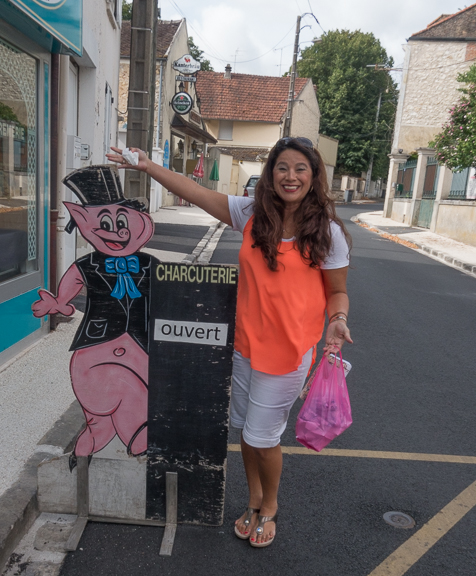 Tuesday we went to one of our favorite small towns, Moret-sur-Loing (for more on Moret, look at Moret-sur-Loing, 2013). Norma had exactly the same reaction we had two years ago: love at first sight. Moret remains a favorite place for us.
Tuesday we went to one of our favorite small towns, Moret-sur-Loing (for more on Moret, look at Moret-sur-Loing, 2013). Norma had exactly the same reaction we had two years ago: love at first sight. Moret remains a favorite place for us.
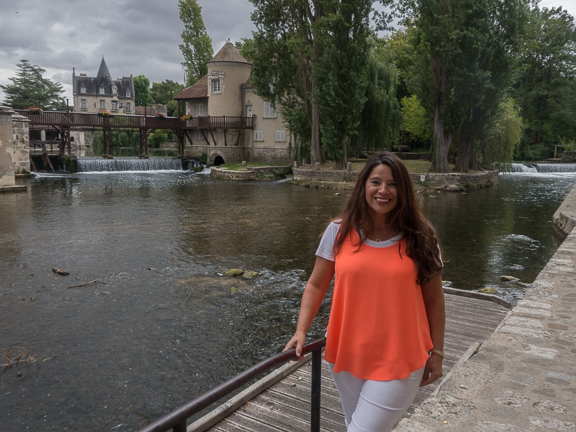
We also had some very nice meals:
Then, it was time to go…
It was great fun to see our friends here, and to show them the city we love and the country-side that we also love.
Tomorrow: off to Brittany.
When we were in France two years ago, we went to La Rochelle after reading Ina Caro’s chapter on this historic city in her book, “Paris to the Past.” Like her, we immediately fell in love with the place and returned later that year. Since then we’ve looked forward to a trip back to La Rochelle and Monday, off we went. We are happy to report that we love this place even more than ever.
First, our hotel. The first trip two years ago we lucked into the best room in the place: top floor, seaward corner. From its balcony we can watch the hundreds of boats going into and out of the harbor, many of them sailing students in classes.We can watch the tide covering and uncovering Richelieu’s Dike, watch the sunset, and just generally enjoy life. This trip I had requested that room when I booked online but when we arrived, we learned that I had mistakenly also asked for a room with twin beds (I don’t remember doing that) and so we had a different room. But the two managers on duty leapt into action with their computers and fifteen minutes later, had re-arranged room assignments so we could have our favorite room. Talk about customer service! Here’s why we like that room:
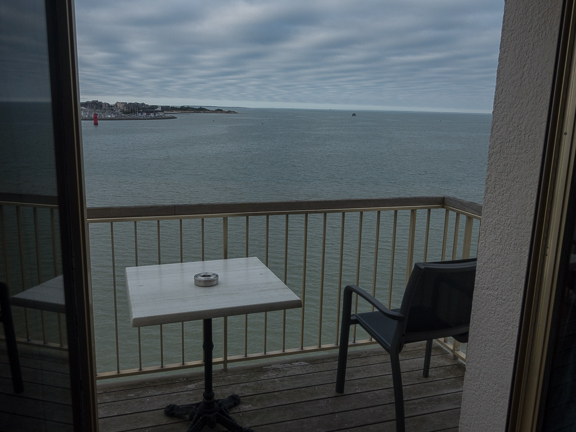
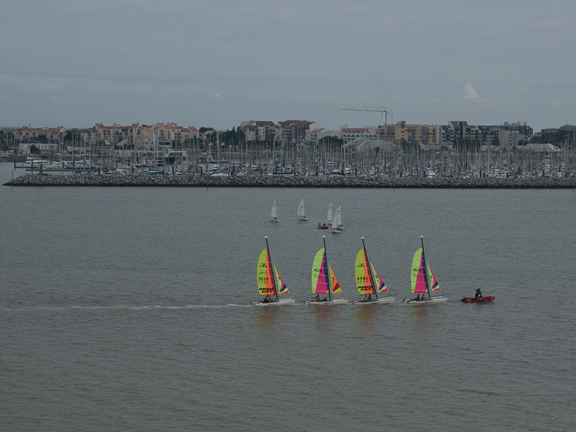
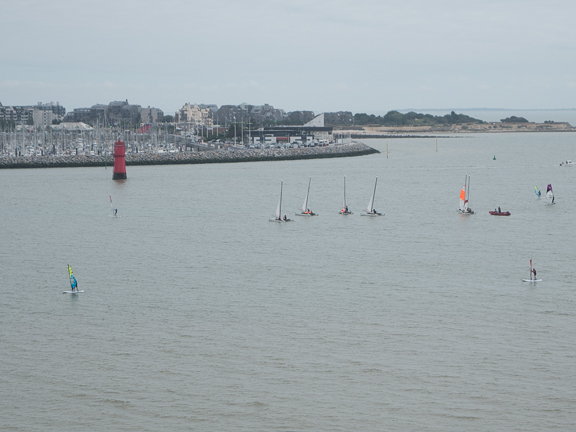
La Rochelle is quite an historic town. For many years it was one of several towns that had permission of the French king to be Protestant. However, in 1627 that paragon of religious tolerance Cardinal Richelieu decided that he’d had just enough of that and laid siege to the city, building a dike across the harbor mouth to prevent La Rochelle from getting food and military supplies from the sea. The city, fearing surrender would mean a repeat of the Huguenot slaughter of 1572, held out. After 14 months, the population had dropped from 28,000 to 5,000 and the city surrendered, losing all its rights to religious freedom. I think the Cardinal forgot the “love your neighbor as yourself” part of his religious training…
Today the city is centered around its old port, which is not much changed from the days of the siege.

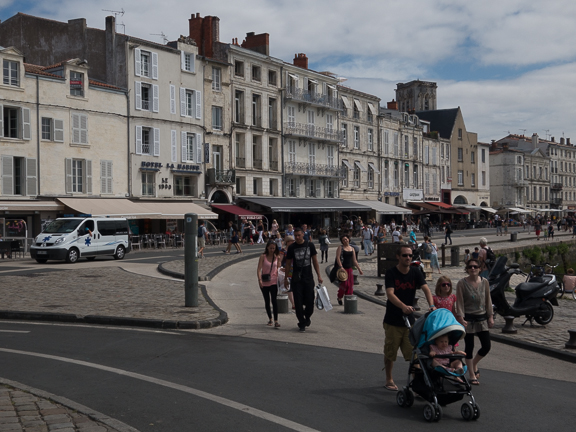
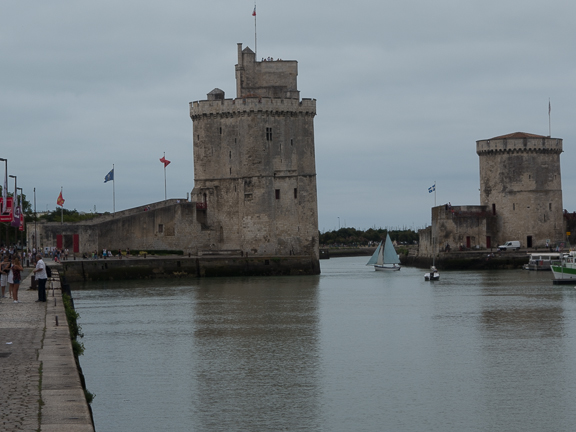
We were a little worried about what it would be like here in the middle of vacation season for the French. It was indeed jammed with French (and some Belgium and Dutch and British) tourists, but we loved even that part; La Rochelle is big enough to absorb them all and they all seemed to be in the area around the old port. There were thousands of tourists – all ages, sizes, shapes, many families, enjoying vacation in the great weather, just as we were. We walked back from dinner at 10:30 the last night, and the area around the old port was jammed. It was great fun, actually.
Laurie is an inveterate shoe-watcher, marveling at the variety of not-exactly sensible footware, particularly since most of these old cities have old cobblestone walks. She made me take this picture of the perfect strolling shoe:
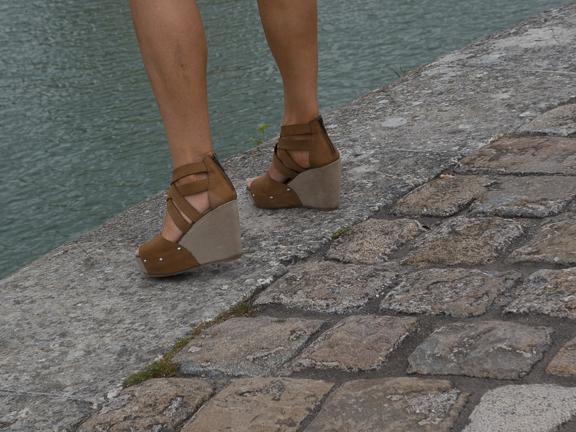
On the other hand (foot?), it was all I could do to keep her from rushing in to buy these shoes:
I talked Laurie out of buying those shoes by pointing out that she had just bought another pair, specially for the trip to La Rochelle. Here’s proof: Laurie’s feet in her new shoes (and our favorite red wine):
Laurie loves to dip her toes in the Atlantic ocean when we’re at La Rochelle. Here she is standing on the only remnant of Richelieu’s dike (see above):
One thing we find interesting about La Rochelle is that the buildings of the downtown area all seem to have survived 300-400 years, not recently restored but continually maintained (not always well). In Paris, you’ll see blocks of beautiful old buildings with a modern monstrosity right in the middle; here, there’s none of that, so the streets have a distinctly ancient feel to them. Take away the cars and the modern stores on the ground floor, and you’re in an 18th century city. Here are some pictures of the downtown area.
And you just have to love the sign on this pharmacy:
We had some fine meals in La Rochelle, as you can imagine for two seafood-loving souls. Dinner our last night was at an excellent restaurant, Le Thiers Temp, where we both had swordfish. Now, I love swordfish and have it every time I can, and I can tell you that this was the best swordfish I’ve ever had, anywhere.
If that restaurant was a bit upscale, the night before? Not so much:
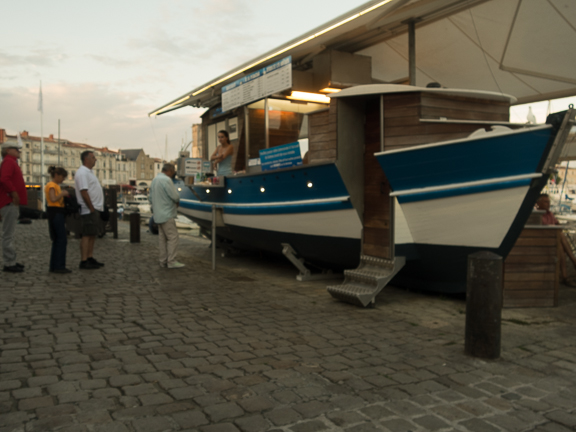
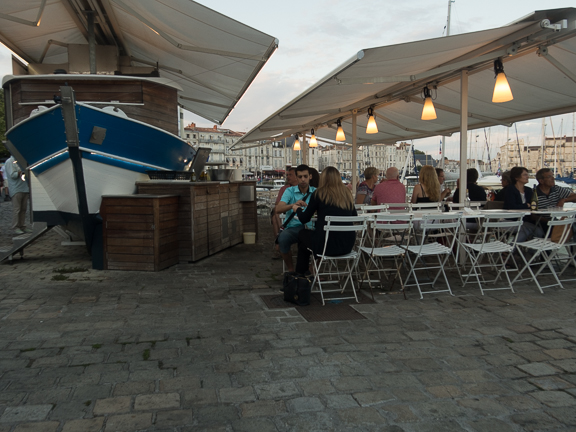
Le P’tit Bleu – we had grilled mussels (every restaurant in La Rochelle must serve mussels) and grilled calamari. You order, get a table in the back and a few minutes later a server shows up with your food, still too hot to eat. Both mussels and clamari were great. We actually love Le P’tit Bleu – great food, low cost, sitting right next to the water of the old port on a warm night. Pretty nice.
La Rochelle has a huge market that seems to be there every day. Want strawberries or raspberries? We got ’em:
Want shoes? We got ’em:
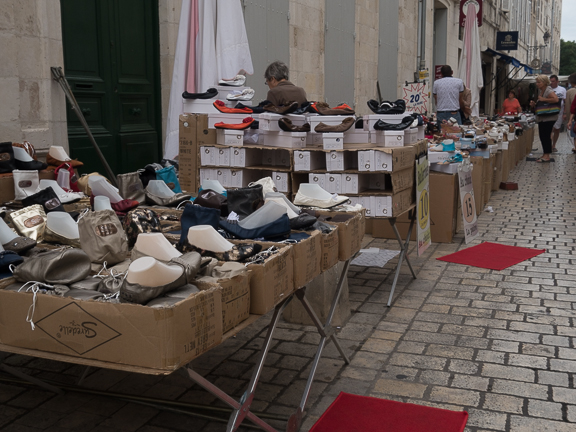 Indeed, this market had pretty much anything you’d want, including a pig’s head and horsemeat. I declined photographing those…
Indeed, this market had pretty much anything you’d want, including a pig’s head and horsemeat. I declined photographing those…
That’s La Rochelle. It is our favorite place in France and right up there on our list of favorite places in the world – maybe at the top. We already are looking forward to returning next year.
Today, we got back to our daily walks, and it felt good to be back and active again! We went earlier than usual this morning because it’s hot, and we returned to the Seine, which we always love to walk along. We walked on the opposite side of the river from Thomery, which we visited a couple days ago (Thomery). As always, we had some surprises…
Here’s the road we walked along. About a third of the walk was on a trail, then we reached this road. Fortunately, not one car came along the road in the hour-plus that we were on it.
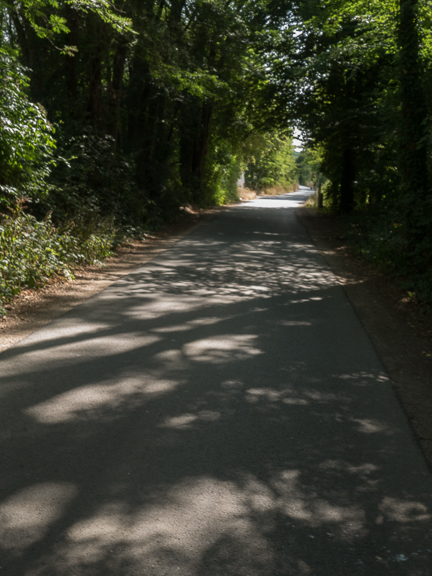
We knew we were walking on the other side of the river from Thomery, and we knew we’d see some sights from that town, but this one surprised us:
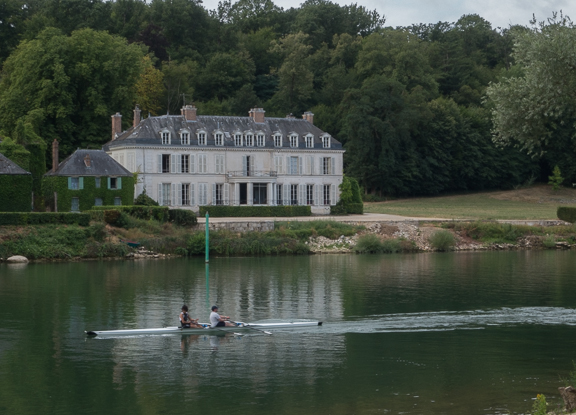 This chateau, named “La Rivière,” is on the northern edge of Thomery. We knew it was there from our earlier walk in Thomery, but we could not see it then. Today we saw it in its full glory. Rather nice, eh? The open windows indicate that someone is living there now. I’m trying to figure out to get a dinner invite, but since I don’t even know who lives there, that might be difficult.
This chateau, named “La Rivière,” is on the northern edge of Thomery. We knew it was there from our earlier walk in Thomery, but we could not see it then. Today we saw it in its full glory. Rather nice, eh? The open windows indicate that someone is living there now. I’m trying to figure out to get a dinner invite, but since I don’t even know who lives there, that might be difficult.
After another ten minutes of walking we could see the small ancient port of Thomery and got a different and lovely view of it from across the river:
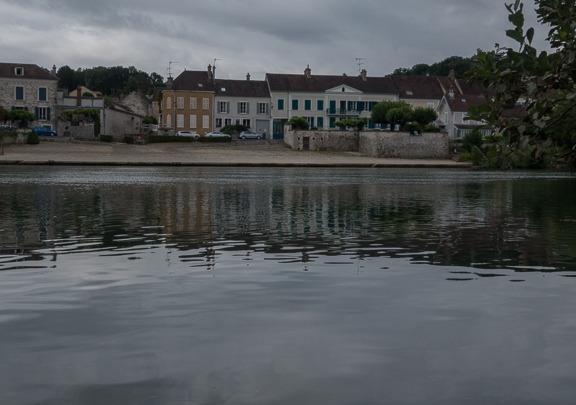
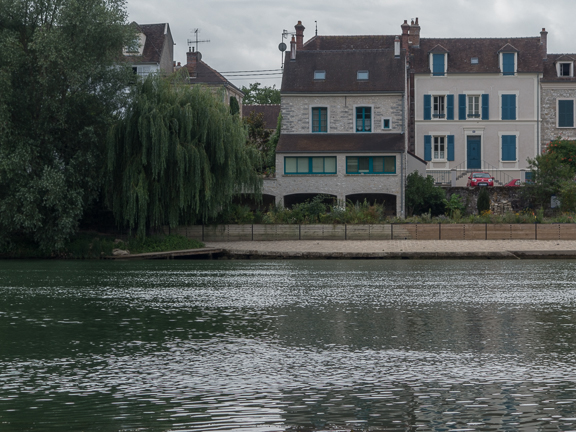
Laurie likes the shutters and beautiful willow tree in the picture above.
After sitting and enjoying this view for a while, it was off again. As we walked down the road we paralleled a railroad track and came to a road going under the track with this sign on it:
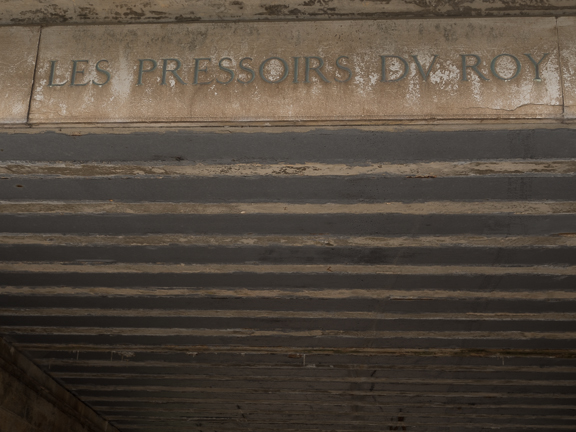
“Les Pressoirs du Roy” translates as “Presses of the King,” presses in this case being cider or wine presses. Totally disregarding the Private Propery sign, we walked under the railroad and came upon this:
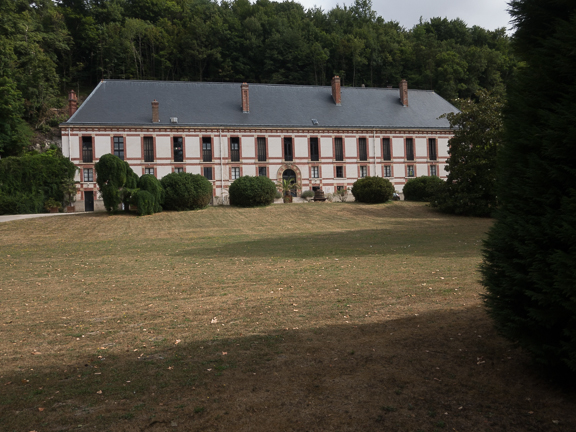
Took a little research (reading a sign) and we learned that this is the “Cognac-Jay Maison d’Enfants À Caractère Social.” I don’t know of a direct comparison with anything in the United States; it’s a home for children who, for some reason or another – usually legal; delinquency, that is – cannot remain in their home and school setting, so they come to a facility such as this. French law established these homes in 1945.
We walked almost two hours today. Going earlier meant it was cooler, and much of the walk was in the shade. We’re glad the temps have cooled a bit (though it’s still sultry). Not much we like better than walking along the river, unless it’s drinking wine, which we like a lot.
We’re off to our favorite place in France day after tomorrow: La Rochelle, a city with a rich history and today entirely dedicated to serving the best seafood in the world. Looking forward to that road-trip!
Road trip! Whoo-hooo! Sunday we packed up the Germain-mobile and went with Mary and Gilles to Lyon, the second-biggest city in France. We probably would not have ever gone to Lyon but friends of ours were staying there for almost three weeks and we really wanted to see them, so this was the perfect time. Well, maybe not perfect, as it was hot-hot-hot in Lyon, the hottest area of France. But that was a minor distraction in a really excellent three-day visit to Lyon.
Let’s get right to the real reason we went to Lyon: to share good food, good wine and good times with Jim and Maryann. Mission accomplished:
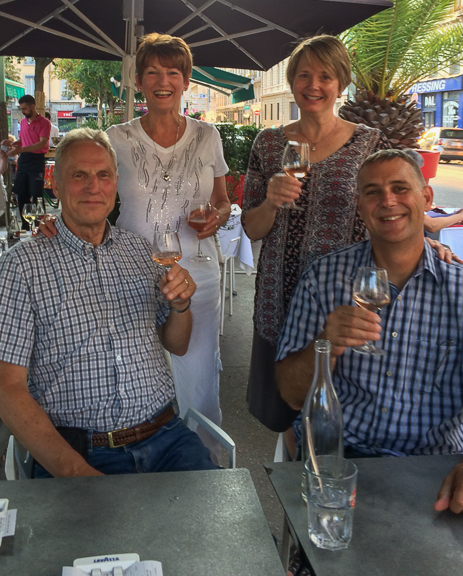
The six of us – Laurie and I, Mary and Gilles, and Jim and Maryann – joined up for dinner two nights and had just the best time imaginable. In the picture above we sat outside in the warm evening: we met at 7:30, drank some vin rosé, had dinner and got up from the table at 11:30. The next night we went to a small typical bouchon, which is what the old, working-class restaurants were called. Now, lots of new restaurants call themselves bouchons. The name really describes a typical bistro-style restaurant serving the food for which Lyon has been famous for centuries. The second night’s dinner started at 8 and we left the restaurant about 11:30. Gotta love those long French meals. The dinners were great both nights – Maryann got to try steak tartare (you’ll have to ask her about it) – and everyone agreed that Lyon’s reputation for gastronomic excellence is no exaggeration. Food alone would be reason to visit this city.
Lyon is famous for two things: food (see above) and silk. In 1535 François I granted a royal charter to two silk merchants in Lyon and, five years later, awarded a monopoly on French silk production to the city. By the mid-1600s, there were over 14,000 looms in Lyon and a third of the city was employed, directly or indirectly, in silk production.
It wasn’t all smooth sailing, though. In the later-1700s automation started coming to the industry, threatening the thousands of canuts (silk workers). In the early 1800s Joseph Marie Jacquard perfected a loom that used punched cards to operate, allowing mass production of even complicated designs and putting out of work about two-thirds of the canuts. They revolted in 1831 and again in 1834, both times occupying the city and finally being beaten by the French Army.
Lyon has several museums dedicated to fabric, silk especially. The biggest, the Musée des Tissus, has many beautiful fabrics showing the history of the design and use of silk. Unfortunately, photography is prohibited there. But, I had to take a picture of these silk shoes:
Today, the most visible remains of the old silk industry are the traboules, hidden passages through buildings that allowed silk to be transported throughout the old city without fear of it being ruined by rain. A number of these traboules still exist; here are some pictures of ones we walked through.
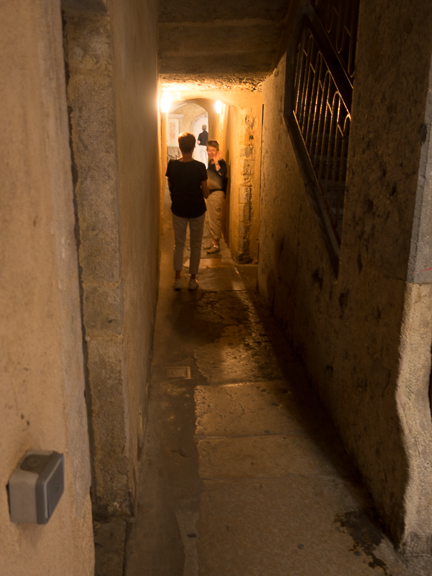 |
| Laurie and Mary in a traboule. This passage was probably built in the mid-1600s |
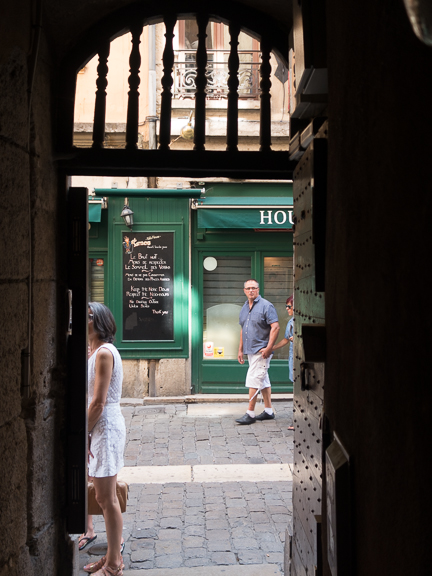 |
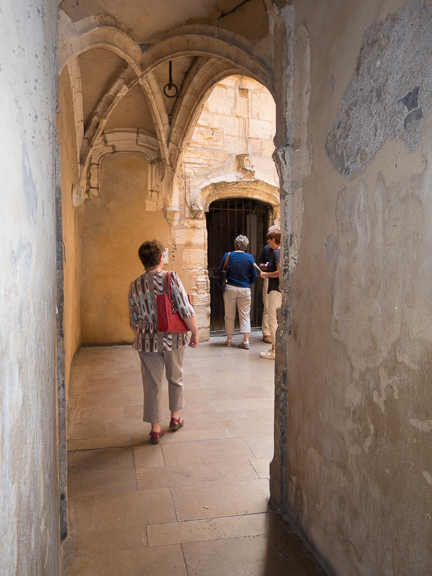 |
The traboules later served another purpose. During the German occupation of World War II, they were used to hide and move through the city Allied airmen who had parachuted from airplanes and escaped capture. Because the entrances to the traboules look just like any other door, the German soldiers looking for airmen could not track their movements. It’s said that many an escaped Allied airman went through the traboules to freedom.
If you’ve been to Paris you’ve surely seen the Basilique du Sacré-Cœur, overlooking the city from the heights of Montmartre. Lyon has a church similar to Sacré-Cœur in many ways, but way different in appearance: the Basilique Notre-Dame de Fourvìere. Both basilicas were built about the same time, in the years immediately after the Prussian invasion of France in 1870-71. Both were built for the same reason: the city believed that Mary had interceded to save the city from the Prussians (though I don’t know how they came to that conclusion in Paris, which was besieged, bombed and occupied by the Prussians) and so both are dedicated to the Virgin Mary. But while Sacré-Cœur has a distinctive white exterior and a decidedly un-interesting interior, Basilique Notre-Dame de Fourvìere has an interesting but not overly-dramatic exterior and an over-the-top interior. Pictures:
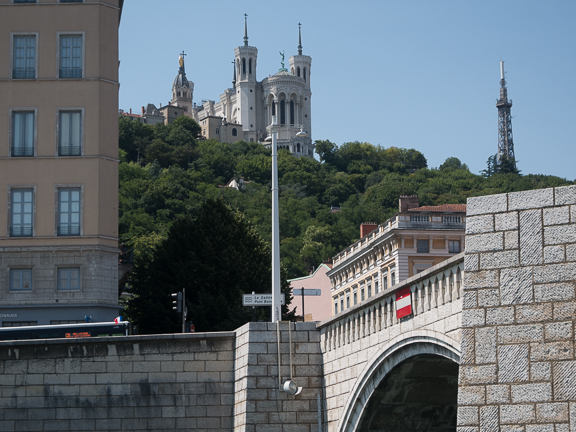
Basilique Notre-Dame de Fourvìer from the River Saône. This is the view you see from everywhere in Lyon.
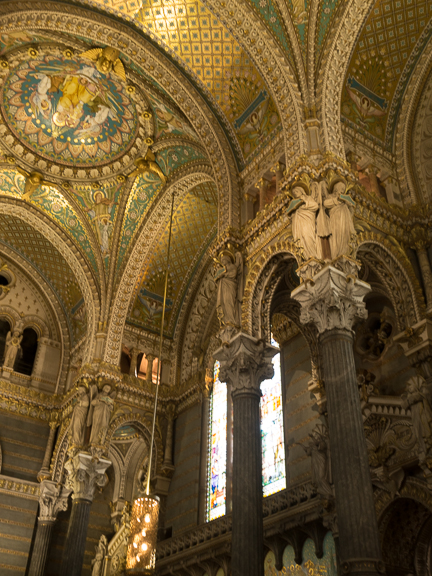
The word “ornate” does not come close to describing this interior. Not even close.
As the peninsula between the Saône and Rhone rivers narrows to a point at which they join, Lyon has built a number of modern buildings. We took a river tour and saw these. I love them.
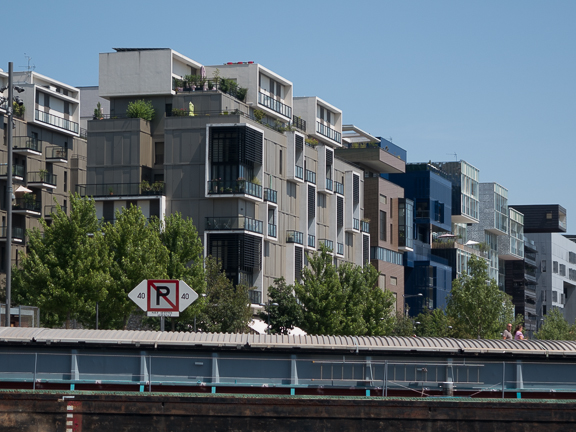 These are apartment buildings. Very cool, we think.
These are apartment buildings. Very cool, we think.
But, as regular readers of this blog – both of you – know, I am not always enamored of modern architecture. Remember the blog on the Louis Vuitton Foundation building in Paris – loved it. Here is Lyon’s museum effort – hate it.
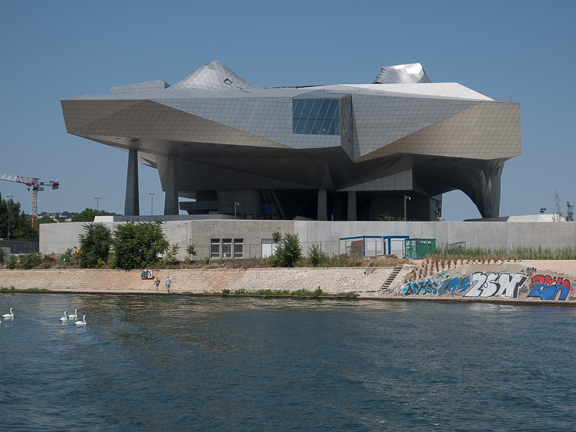
Where Frank Gehry’s building for Vuitton Foundation soars gracefully (as does his Guggenheim museum in Bilbao, Spain), this building seems heavy and clunky and decidedly un-beautiful. Just my opinion…
For some other more classical buildings that we love…along the Saône River, seen from our river tour.
Many of the buildings in the historic part of Lyon maintain the tradition of small signs handing above them. A few I saw:
And one last topic. Philippe DeLormé was a French architect of the 1500s. He was arguably the premier Renaissance architect in France, designing chateaux for Henri II. One of his first designs is in Lyon, where he was commissioned to create stairs and a gallery to connect two existing buildings, in a courtyard. The courtyard remains and I think it’s a fascinating lesson on how the Remaissance changed architecture. Here are a couple pictures of his gallery and staircases; compare them to the buildings on the sides. The latter are pretty plain; DeLormé’s gallery is beautiful.
Gotta love technology…
Checked email this morning and found two odd things: first, an email from the Internet provider that serves up this blog saying the storage for this blog was 98% full. As it’s been about a third full, something was not right; second, all emails to john@zumsteg.us and laurie@zumsteg.us between June 20 and this morning have disappeared. As in, gone.
After a long on-line chat with the first-level tech guy at my hosting provider, he turned the mess over to Tech Support, which will try to find out what’s gone wrong.
Then I discovered that all the pictures I’ve posted to the blog since June 20 are gone also. So if you look at some of the recent posts there may be placeholders instead of pictures. I will leave everything alone until Tech Support figures out what’s gone wrong.
I’ve been fiddling with computers long enough to know that those three problems – a erroneous report of storage used, lost emails and missing pictures – are not isolated, un-related incidents, especially when two of them are related to a specific date. That would be too great a coincidence to have three serious things go wrong and not be related. I’m hopeful I’ll have a fix today and all will be well.
Update: as of late Friday, almost all emails have been recovered and the pictures should be back on this blog. I haven’t received – and likely will not received – a good answer as to what went wrong, but that’s okay, as long as everything is working again. I do give credit to my hosting service, A Small Orange – yes, that’s really its name – as they had four or five people working the problem yesterday. I do know it wasn’t isolated to my account and I do know I was right – a number of directories on my site had been reset to what they contained on June 20. I’m sure any technical explanation would go right over my head.
Today we walked in Thomery, a small town on the Seine not far from here. Last trip we’d been told that there was a beautiful walk in Thomery but we sure didn’t find it and were disappointed in the town. We heard a week ago, though, that Thomery has an interesting history, and that it’s possible to see and walk through that history, so off we went, and this time we were successful. We found a rewarding walk and an unusual bit of history.
The first official mention of Thomery is in some records of 1380. Yes, 1380. The town became famous in the 18th century when the chasselas grape became the favorite table grape of the French court and quickly after that, of all Paris. In the late-1800s, the town shipped 800 tonnes of this grape to Paris.
The visible part of this history is that the grape was grown on stone walls, and most of those walls still exist today. Now, they mark the boundaries of land attached to houses. There were once over 200 kilometers of these walls in Thomery; I suspect most still exist, though few are used to grow grapes anymore.
In its grape-growing heyday, someone determined that the optimal distance between these walls was 9 meters – about 30 feet. So row upon row of stone walls, about 7 – 10 ft tall, were constructed. Here is a Google Earth view of the central part of Thomery – you can see all the walls. This is maybe a quarter of the town, and almost all of it has these walls.
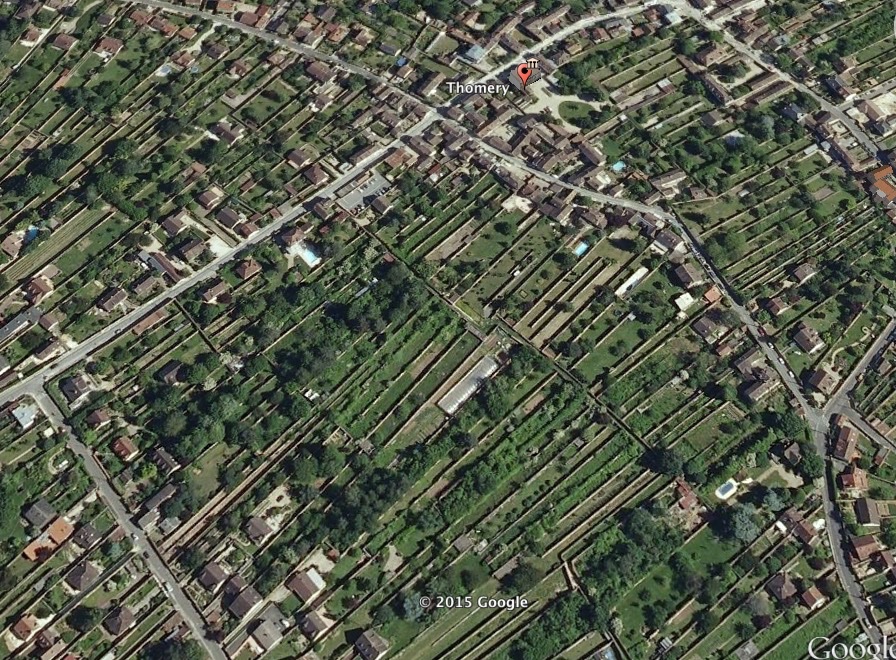
You can also see a diagonal path running through the center section of the walls, from upper-left to lower-right; this is the path we walked. Most of the plots of land are walled along the path, so we were unable to see into most of the yards, but where we could see into a yard we got a good idea of how these walls were used to grow the chasselas grape. Here are some pictures along the path.
Below you see the path itself. The walls on either side border the yards of private houses, whose yards are bordered by those 400 year-old grape walls.
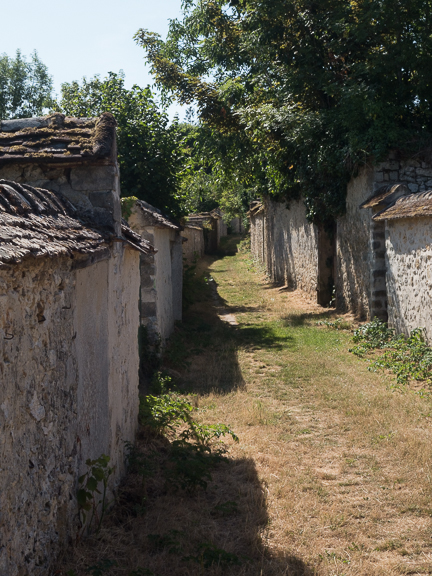
Here you see some walls in their original place. It’s nine meters between the walls, which varied in length; many of them are several hundred meters long.
Some walls do still have grapes growing on them, but they are few in number. The chasselas grape is grown in Switzerland now, and Thomery does grow and sell some, but it’s mostly an artisan industry now.
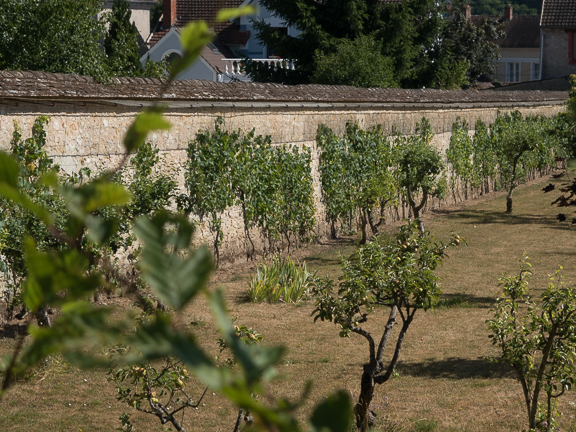
The second part of our walk proceeded along the Seine and ended at the old port of Thomery. Here the grapes (and other fruits from the area) were shipped to Paris by river. They could leave at night and be in Paris for the next day’s markets. The biggest – and heaviest by far – product shipped from here were stone blocks, quarried from nearby and shipped to Paris for its buildings. This area became prosperous and has some beautiful houses on the main streets to and from the port.
The view upriver from the port…
…and down river.
Ah-ha! Another affolante! (For more about affolantes, see Affolantes in Bois-le-Roi)
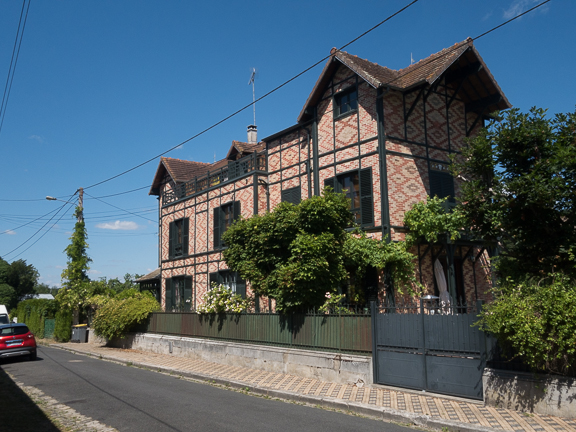
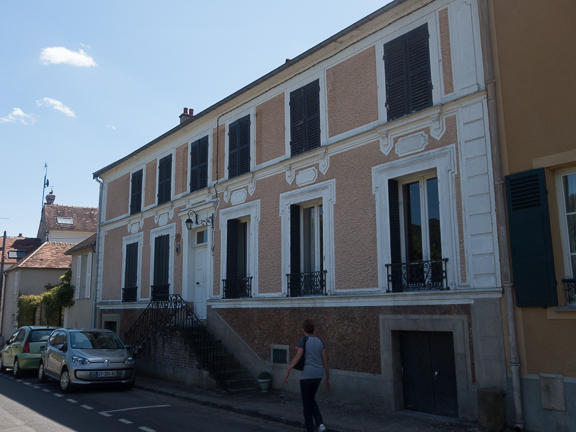
And because someone knew Laurie was missing her Alaska roots, they put a totem pole in the backyard, just for her, I’m sure.
We’ll be back to Thomery, as we think there are more things to see, including some beautiful buildings along the Seine. We’re thankful to Benoit, who told us about the path through the walls, making us go back to Thomery after a first disappointing trip. There are so many places like Thomery, small towns each of which have histories going back centuries. Often, some remnant of that history is still there and can be seen – just takes a bit of perseverence. We persevered with Thomery and were rewarded.
“La Canicule” is French for “heat wave,” and that is exactly what we’ve had. This afternoon (Saturday, July 4; oddly enough, in France July 4th is just another day) it’s about 82F with some rain and thunder showers. That’s the coolest afternoon we’ve had in a week, and it’s going to stay in the mid- to high-80s for a week. Last Tuesday it was 102F here; broke a record for the day.
I find it humorous that the French word for heat wave is pronounced “can-i-cool.” Should be “canihot” or something.
The heat caused us to curtailed our activities some, but we moved in the middle of la canicule. Our stay in the cottage came to an end when we moved into our house-sit. We’ll be here until August 31, and I can tell you, this will be a nice stay. This is a beautiful house, in a beautiful village. We’re only ten minutes away from Bois-le-Roi, where we’ve lived for the last seven weeks, so we’ll still be going there for the great cheese and boulangerie.
Here’s the front of our new residence. The house was built in 1923 and seriously remodeled when the current owners moved in eight years ago. You can’t see the remodel from the front; the entire first floor back wall was removed and the kitchen expanded and a living area added.
And the view from our bedroom. We love the window flowers – they’re everywhere.
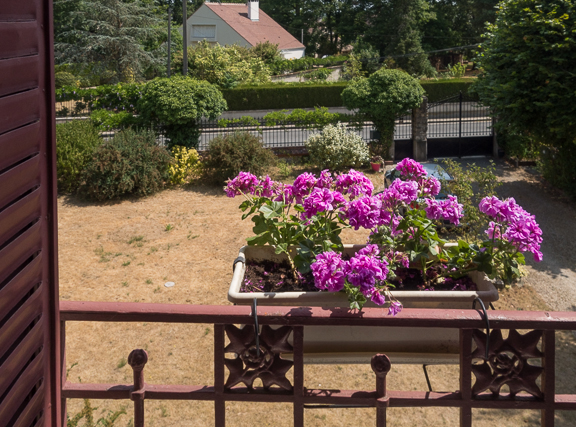
As the weather is starting to moderate a bit, we’ll get back to our ambles and rambles – a week from tomorrow we go to Lyon with Mary and Gilles – and I’ll be a bit better about posting.
Gilles provided me with more information about how the French came to call a heat wave “canicule.” Canicule derives from the Latin, canicula, which translates as “little dog.” Canicula is also an alternative name for the constellation canis major (“big dog”). That constellation has, for centuries and in many cultures, been associated with the hottest days of summer. Hence: canicule – heat wave. Thank you, Gilles!
P.S. Don’t ask me how the meaning went from canicula – little dog – to canis major – big dog. I don’t know. Maybe the little dog grew up.